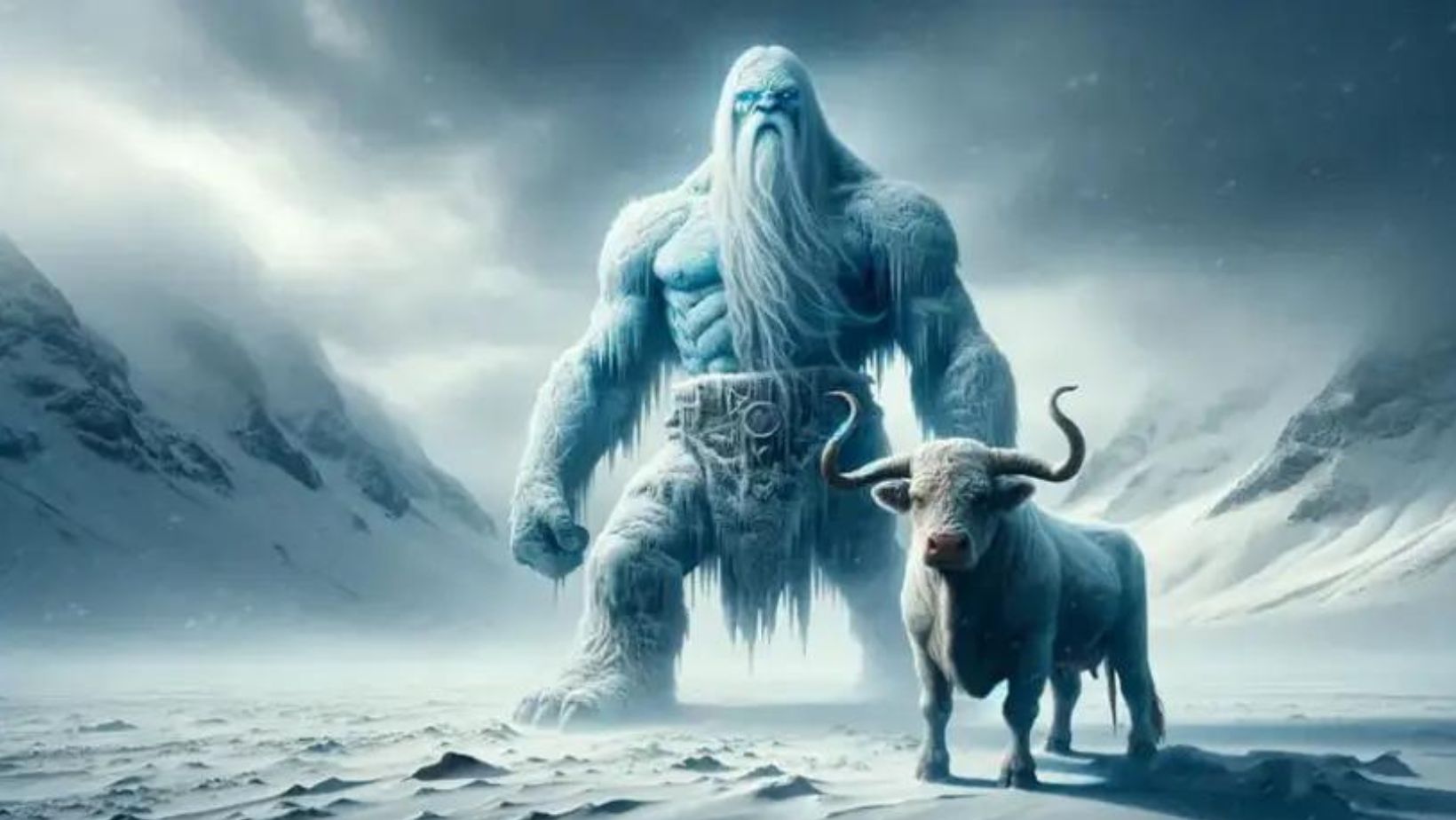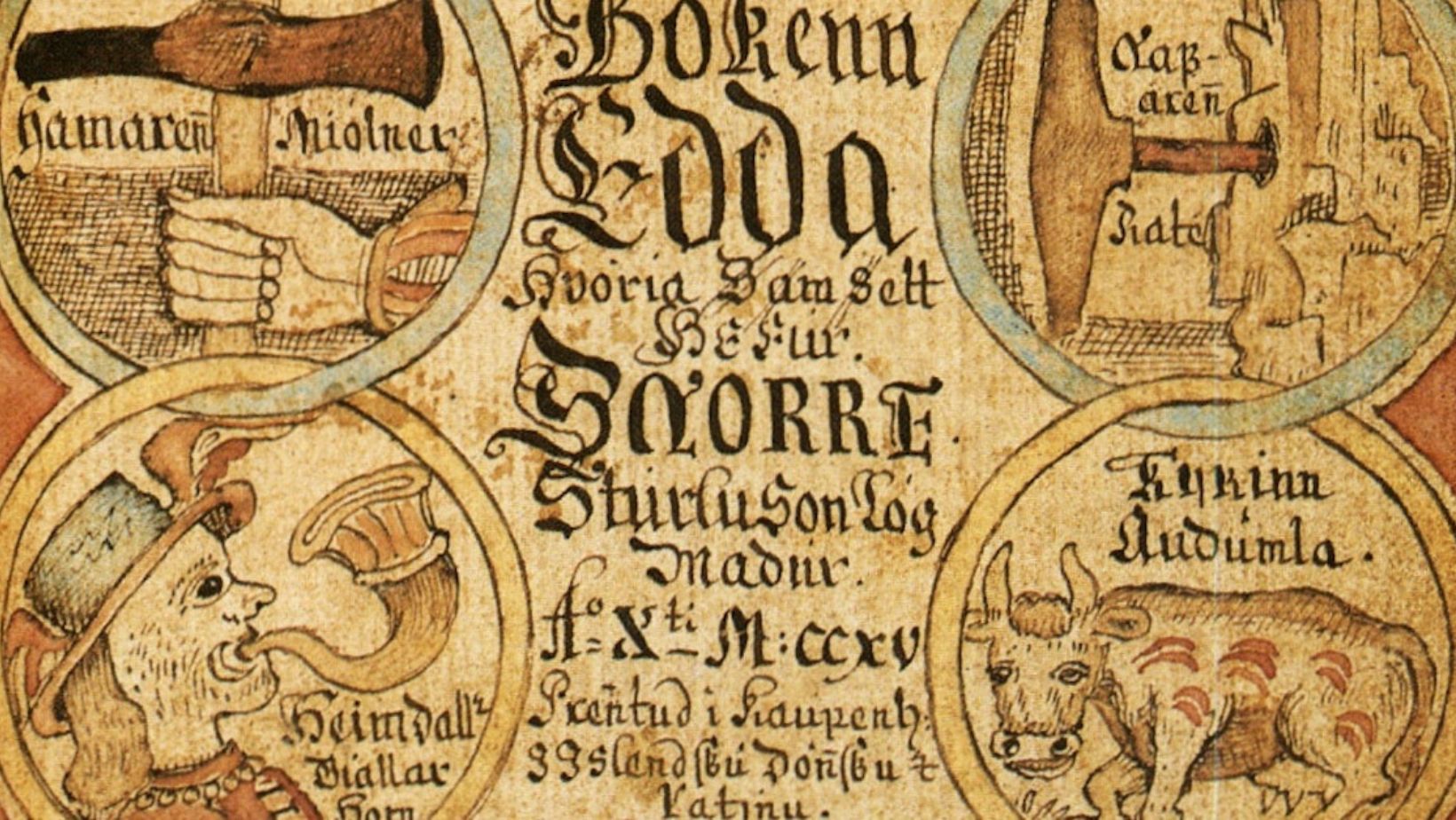In the misty depths of Ymir Norse mythology, there’s a figure so colossal, so ancient, that his very existence sets the stage for all creation. I’m talking about Ymir, the first being to emerge from the void, the ancestor of giants, and the unwitting donor of his own body parts to craft the world as we know it. Pretty metal, right?
But who exactly was Ymir, and why should you care about this frosty giant? Well, buckle up because we’re about to embark on a journey through the Norse cosmos, starting with the big guy himself. By the end of this, you’ll see why Ymir is one of the most fascinating and important figures in all of Norse mythology. Trust me, you don’t want to miss this.
Table of Contents:
- Ymir: The Primordial Giant of Norse Mythology
- The Birth of Ymir and the Primordial Realm
- Ymir’s Hermaphroditic Nature and Offspring
- The Aesir Gods and the Creation of the World
- Ymir’s Body as the Foundation of the Cosmos
- Parallels and Influences in Other Mythologies
- Ymir in Old Norse Literature and Modern Adaptations
- Conclusion
Ymir: The Primordial Giant of Norse Mythology

In the fascinating world of Norse mythology, Ymir stands out as a pivotal figure. This primordial giant played a crucial role in the Norse creation myth, setting the stage for Norse cosmology.
Origins of Ymir
Ymir, also known as Aurgelmir, was the first sentient being to emerge from the primordial chaos of Ginnungagap. Born from the melting ice of Niflheim and the sparks of Muspelheim, Ymir was a frost giant of immense size and power.
Role in Norse Creation: Ymir Norse Mythology
According to the Norse creation story, the gods Odin, Vili, and Ve used Ymir’s body to create the world as we know it. They fashioned the earth from his flesh, the mountains from his bones, and the sky from his skull. Ymir’s blood became the oceans, and his hair became the trees.
Significance in Norse Mythology
Ymir’s role in Norse mythology cannot be overstated. As the first being and the source of all creation, he represents the raw materials from which the ordered universe was formed. His story also showcases the cyclical nature of Norse cosmology, with creation stemming from chaos and destruction.
The Birth of Ymir and the Primordial Realm: Ymir Norse Mythology
Ginnungagap: The Primordial Void
This void existed between the realm of ice, Niflheim, and the realm of fire, Muspelheim. It was in this space that the first beings, including Ymir, came into existence.
Niflheim and Muspelheim
Niflheim, the realm of ice and mist, and Muspelheim, the realm of fire, played a crucial role in Ymir’s birth. The ice from Niflheim melted due to the heat emanating from Muspelheim, and the drops formed the first living being, Ymir.
Emergence of Ymir: Ymir Norse Mythology
As the ice melted and the sparks flew, Ymir emerged from the primordial chaos. His emergence marked the beginning of life and the eventual formation of the Norse cosmos.
Ymir’s Hermaphroditic Nature and Offspring: Ymir Norse Mythology
Ymir’s Dual Gender
One of the most intriguing aspects of Ymir is his hermaphroditic nature. As a primordial being, Ymir possessed male and female attributes, allowing him to reproduce asexually and give birth to other giants from his own body.
Birth of the Jotnar
These giants, both male and female, emerged from Ymir’s sweat and included the first ancestors of the frost giants. The Jotnar would go on to populate the realm of Jotunheim and play a significant role in Norse mythological narratives.
Thrudgelmir and Bergelmir: Ymir Norse Mythology
Among Ymir’s notable offspring were Thrudgelmir, a six-headed giant, and Bergelmir, who survived the great flood caused by Ymir’s blood during the world’s creation. Bergelmir and his wife were said to have repopulated the world with giants after the flood, ensuring the continuation of Ymir’s lineage.
The Aesir Gods and the Creation of the World: Ymir Norse Mythology
Audhumla and Buri
As Ymir emerged from the primordial ice, so did the cosmic cow Audhumla. Audhumla nourished Ymir with her milk, and as she licked the salty ice blocks, she uncovered Buri, the first of the Aesir gods. Buri’s son, Borr, would later father Odin, Vili, and Ve, the trio responsible for creating the world from Ymir’s body.
Odin, Vili, and Ve
Odin and his brothers, Vili and Ve, were the sons of Borr and the grandsons of Buri. These three gods were responsible for creating the world from Ymir’s body. They slew the primordial giant and used his various body parts to form the different elements of the cosmos, bringing order to the chaotic primordial realm.
Ymir’s Death and the Creation of Midgard: Ymir Norse Mythology
The death of Ymir at the hands of Odin, Vili, and Ve marked a pivotal moment in Norse cosmology. The gods killed the primordial giant and used his body to create the world. Ymir’s flesh became the earth, known as Midgard, while his blood formed the oceans and seas. This act of creation from destruction highlights the cyclical nature of Norse mythology and the role of sacrifice in the formation of the ordered universe.
Ymir’s Body as the Foundation of the Cosmos: Ymir Norse Mythology
In Norse mythology, Ymir’s body was the foundation for the entire cosmos. The gods used each part of his massive form to create the various elements of the universe.
Flesh Became Earth
After Odin and his brothers slew Ymir, they used his flesh to create the earth known as Midgard. This act of creation from the giant’s body emphasizes that the ordered world was built upon the remnants of primordial chaos.
Blood Became Seas: Ymir Norse Mythology
Ymir’s blood, which flowed freely after his death, was used by the gods to create the oceans and seas surrounding the earth. The vast quantities of blood that poured from Ymir’s body were said to have caused a great flood, which drowned many of the giants.
Bones Became Mountains
The gods used Ymir’s bones to form the mountains and hills that dot Midgard’s landscape. This creation of landforms from the giant’s skeletal structure adds to the imagery of the world being built from the remnants of a once-living being.
Hair Became Trees
This aspect of the creation story imbues the natural world with a sense of vitality and connection to the primordial giant.
Skull Became the Sky
The gods fashioned the sky from Ymir’s skull, creating a vast dome over the earth. This celestial canopy reminds us of Ymir’s immense size and the scale of the creation event.
Parallels and Influences in Other Mythologies: Ymir Norse Mythology
The Norse creation myth involving Ymir shares similarities with other creation narratives worldwide, suggesting the possibility of cultural exchange and influence between ancient societies.
Similarities with Other Creation Stories
Many cultures have the concept of a primordial being whose body creates the various elements of the universe. For example, the Babylonian creation epic Enuma Elish features the god Marduk creating the world from the body of the primordial goddess Tiamat.
Zoroastrian Parallels
The Norse creation story also resembles the Zoroastrian creation myth. In Zoroastrianism, the primordial bull, Gavaevodata, is sacrificed by the deity Ahriman, and its body is used to create the world. The similarities between these narratives suggest the possibility of cultural exchange and influence between ancient Indo-European societies.
Indo-European Mythological Connections
As Norse mythology is part of the larger Indo-European mythological framework, it is unsurprising to find parallels between the Ymir creation story and other Indo-European creation myths. The concept of a primordial being, often a giant or a cosmic egg, giving rise to the universe is a recurring theme in many Indo-European mythologies, pointing to a shared cultural heritage and the deep roots of the Ymir narrative in ancient Indo-European traditions.
Ymir in Old Norse Literature and Modern Adaptations: Ymir Norse Mythology
The story of Ymir and the Norse creation myth is preserved in various Old Norse literary sources and inspires modern retellings and adaptations.
Ymir in the Poetic Edda
The Poetic Edda, a collection of Old Norse poems, contains several references to Ymir and his role in creating the world. The poem Völuspá, in particular, describes the creation of the world from Ymir’s body and the establishment of the cosmic order by the gods.
Snorri Sturluson’s Prose Edda

Snorri Sturluson, an Icelandic scholar and poet, compiled the Prose Edda in the 13th century. This work contains a systematic account of Norse mythology, including the story of Ymir and the creation of the world. Snorri’s retelling of the Ymir myth has influenced modern understanding of Norse cosmology and has been a primary source for many subsequent adaptations and interpretations.
Modern Retellings and Adaptations
The story of Ymir and the Norse creation myth has inspired numerous modern retellings and adaptations across various media. From literature to comic books, film, and television, the primordial giant and his role in creating the world continue to capture audiences’ imaginations. These modern interpretations often seek to explore the timeless themes and symbolism embedded in the Ymir narrative, ensuring that this ancient myth remains relevant and engaging for contemporary audiences.
Key Takeaway: Ymir Norse Mythology
Ymir, the first being in Norse mythology, was born from melting ice and sparks. His body created the cosmos: flesh formed the earth, blood became oceans, bones turned into mountains, hair grew as trees, and his skull made the sky.
Conclusion: Ymir Norse Mythology
So there you have it, the story of Ymir, the primordial giant who started it all. From his emergence in the void to his grisly demise at the hands of the gods, Ymir’s tale is one of cosmic proportions. His body became the building blocks of the Norse universe, a reminder of the cyclical nature of creation and destruction in Norse mythology.
But Ymir is more than just a creation myth. He represents the raw, untamed power of the primordial world, a force that even the gods had to reckon with.
So the next time you look up at the sky or feel the earth beneath your feet, remember Ymir, the primordial giant of Norse mythology. His story may be ancient, but its themes of creation, sacrifice, and the interconnectedness of all things still resonate with us today. And that, my friends, is why the tale of Ymir will never be forgotten.

